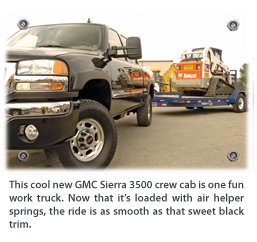Air Support
With winter in full swing for much of the country, the need to properly support the snow-related items you carry on your truck is important. From snow plows to heavy winches, understanding how not to overload your truck for winter activities could save your suspension.
Trucks are designed with a specific load capacity that manufacturers recommend to be the maximum amount of weight that particular vehicle should carry, known as Gross Vehicle Weight Rating (GVWR). When drivers add weight for their individual needs — be it for plowing the neighbor’s driveway or towing a piece of heavy machinery — the trucks can quickly maximize those weight capacities. Even hauling a couple of loads of firewood to heat your workshop can be enough to sag a super duty truck.
We all see examples of un-level vehicles on the road everyday. A loaded truck travels down the highway, its bumper narrowly passing over the asphalt while the driver unknowingly wreaks havoc on the vehicle’s suspension, tires and brakes. Not only is this practice damaging to the vehicle and uncomfortable for the driver, it can be unsafe to everyone on the road. If a vehicle is improperly carrying a heavy load, it can lead to difficulty steering and controlling the vehicle, increased tire and shock wear and reduced braking effectiveness, among other problems.

The type of air suspension your truck requires depends largely on the truck’s primary function. Whether you’ll be adding weight to the front of your vehicle or in the bed of your truck, air helper springs are available to support both in-bed loads and front suspensions. For example, packing the pounds to the front of your truck with a snowplow or similar equipment requires a product that helps reduce fatigue by preventing a truck’s factory suspension from sagging. The air springs work to maintain a level truck by adjusting for varying loads and road conditions easily — simply increase or decrease the air pressure in the springs. That’s the benefit of using air to support your truck.
In contrast, a truck towing a Bobcat skid steer loader or Polaris RANGER, which can weigh several thousand pounds, needs rear helper springs that install between the frame and axle to provide support. Just be certain to know your GVWR and the weight of the load you’re carrying because most suspension support systems are designed to provide extra assistance for heavy loads, not to increase the maximum load-carrying capacity of the vehicle.
Installing a set of air helper springs is a relatively easy process that many do-it-yourselfers can handle, requiring some basic tools like a socket wrench set, drill and jack. So take the time to investigate air helper springs before assuming your truck can handle that extra generator in the bed or it may put her over the edge for good.
Depending on the application, most air helper springs can be added to trucks, SUVs and vans in one to two hours by installing the springs between the frame of the vehicle and the suspension. Many no-drill kits are also available and utilize a vehicle’s factory holes for easy installation. These kits come with all necessary components to install air helper springs in about half the time. Ride-Rite Air Helper Spring kits retail between $250 to $350.


Comments are closed here.